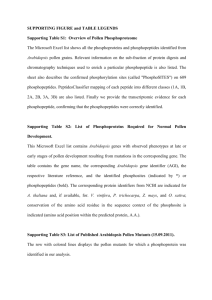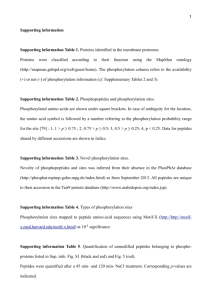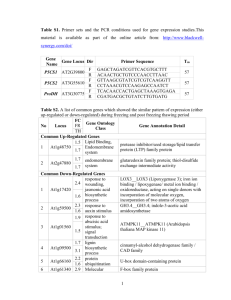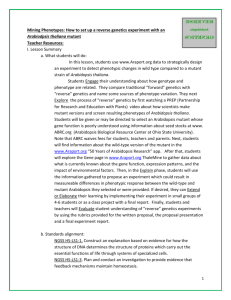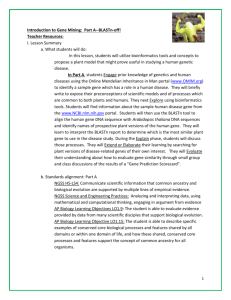TPJ_5061_sm_Supporting-information
advertisement
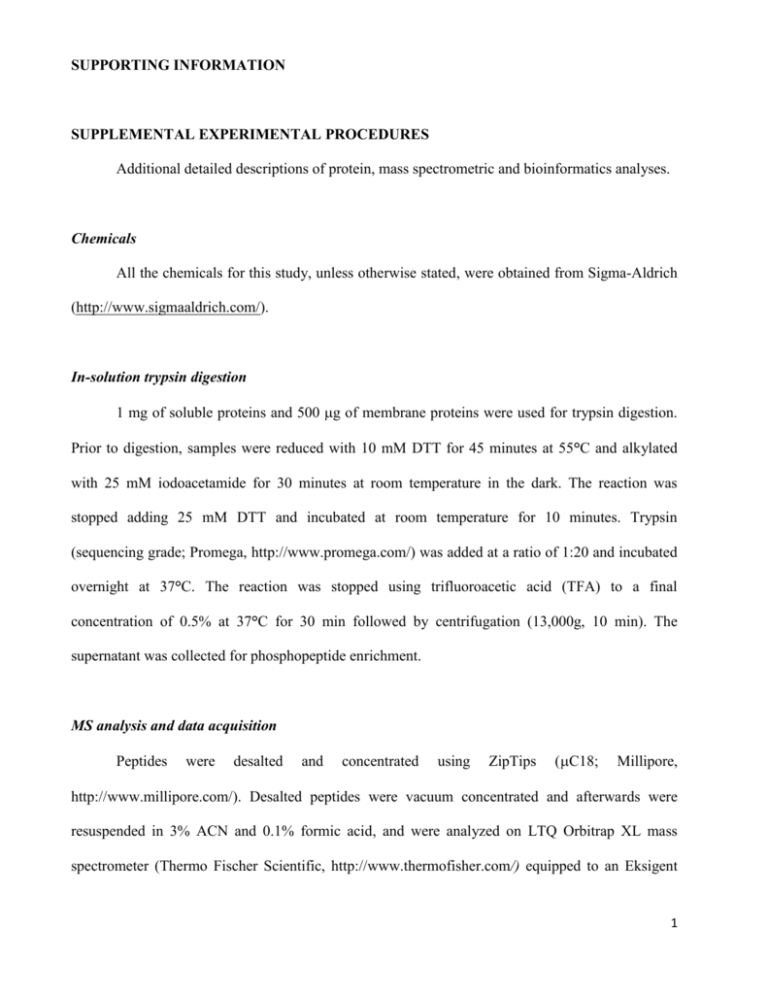
SUPPORTING INFORMATION SUPPLEMENTAL EXPERIMENTAL PROCEDURES Additional detailed descriptions of protein, mass spectrometric and bioinformatics analyses. Chemicals All the chemicals for this study, unless otherwise stated, were obtained from Sigma-Aldrich (http://www.sigmaaldrich.com/). In-solution trypsin digestion 1 mg of soluble proteins and 500 g of membrane proteins were used for trypsin digestion. Prior to digestion, samples were reduced with 10 mM DTT for 45 minutes at 55°C and alkylated with 25 mM iodoacetamide for 30 minutes at room temperature in the dark. The reaction was stopped adding 25 mM DTT and incubated at room temperature for 10 minutes. Trypsin (sequencing grade; Promega, http://www.promega.com/) was added at a ratio of 1:20 and incubated overnight at 37°C. The reaction was stopped using trifluoroacetic acid (TFA) to a final concentration of 0.5% at 37°C for 30 min followed by centrifugation (13,000g, 10 min). The supernatant was collected for phosphopeptide enrichment. MS analysis and data acquisition Peptides were desalted and concentrated using ZipTips (C18; Millipore, http://www.millipore.com/). Desalted peptides were vacuum concentrated and afterwards were resuspended in 3% ACN and 0.1% formic acid, and were analyzed on LTQ Orbitrap XL mass spectrometer (Thermo Fischer Scientific, http://www.thermofisher.com/) equipped to an Eksigent 1 nano LC system (Eksigent Technologies, http://www.eksigent.com/). Peptide separation was made using self-packed (75 µm × 80 mm) reverse phase column packed with C18 material (AQ 3 M, 200A0; Bischoff GmbH, http:// www.bischoff-wohnen.de/). Solvent composition at the two channels was 0.2% formic acid, 1% ACN for channel A and 0.2% formic acid, 80% ACN for channel B. Peptides were loaded from a Spark Holland auto sampler (http://www.sparkholland.com/) and separated using a gradient elution from 3% to 35% ACN in 96 min with a flow rate of 200 nL min-1. Full-scan MS spectra (m/z 300−2000) were acquired with a resolution of 60000 at m/z 400 after accumulation to a target value of 500,000. Up to six data dependent collision induced dissociations (CID) MS/MS spectra were recorded in an ion trap above the threshold of 500, using a normalized collision energy of 35% and an activation time of 30 ms. Charge state screening was enabled and singly charge states were rejected. Precursor masses already selected for MS/MS were excluded for further selection for 120 s and the exclusion window was set to 20 ppm. The size of the exclusion list was set to a maximum of 500 entries. The mass spectrometer was calibrated using the manufacturer’s protocol and during the analysis the orbitrap was recalibrated using internal lock mass on m/z 429.088735 and m/z 445.120025. Data refinement and bioinformatics mgf files were generated from the raw files for all the MS/MS data with the Mascot distiller 2.3 (Berndt et al., 1999) and were searched against a reversed Arabidopsis TAIR 10 database containing contaminants (human keratins and bovine proteins) using MASCOT 2.3 (Matrix Science, http://www.matrixscience.com/) (Perkins et al., 1999). Carbamidomethylation (Cys) modification was kept fixed and oxidation (Met) along with carbamidomethyl (Asp, His, Lys, Glu) (N-term), deamidated (NQ), Gln pyro-Glu (N-term Q), and phosphorylation of Ser, Thr and Tyr was kept as variable modification. A maximum of one missed cleavage on tryptic peptides were allowed. All 2 other precursor ions subjected to MS/MS were searched with a parent mass error tolerance of 10 ppm and a fragment ion error tolerance of 0.8 Dalton. Resulting Mascot result files were parsed into a relational PostgreSQL database of B-fabric (local LIMS) (Turker et al., 2011) using the MS parser library from Matrix Science (http://www.matrixscience.com/msparser.html). Peptides scoring with Mascot ion score ≥ 35 were accepted for identifications if they were identified on rank one and a significant top ranking (bold red). Then, to increase the quality of the data and to decrease the false discovery rate (FDR), we manually validated the entire single hit MS/MS spectra (168). All protein identifications by peptide assignment were validated manually by two mass spectrometrist and conflicting judgments were validated by the third mass spectrometrist. If the peptide was conserved among more than one protein, then the protein with additional peptides was selected. However, if no additional peptides were identified for the proteins then only one protein was selected (based on Arabidopsis Genome Initiative (AGI) ranking). Furthermore, PeptideClassifier (Grobei et al., 2009; Qeli and Ahrens, 2010) was used to classify the peptides into six different classes (1A, 1B, 2A, 2B, 3A, 3B) based on the information content for each peptide. Class 1A peptides are the most informative as a peptide unambiguously identifies a unique protein sequence and a gene locus. Class 1B peptides unambiguously identify a protein sequence but it can be encoded by several splice isoforms of the same gene model. However, all isoforms of class 1B encode the identical protein sequence, i.e. their transcripts only differ in the 5′ and/or 3′ UTRs. Class 2 peptides can unambiguously be assigned to a specific gene model but cannot distinguish between several splice isoforms. Class 3A peptides unambiguously identify one protein sequence but this sequence can be encoded by several gene models from distinct loci. Class 3B peptides cannot be assigned to a particular protein sequence or gene locus and thus represent the least informative class. Therefore, particularly for class 3B peptides, we reported the minimum and maximum number of proteins identified by each class 3B peptide. 3 Phosphorylation sites mapping on phosphopeptides were confirmed using a normalized delta ion score (ΔI) by taking the difference of Mascot ion score between the rank 1 and rank 2 assignments and dividing that difference by the Mascot ion score of rank 1 phosphopeptide. The phosphorylation site was confirmed when the Δ Ion score ≥ 0.4 (Reiland et al., 2009; Elias et al., 2004; Beausoleil et al., 2006)). Phosphopeptides with a confirmed phosphorylation site were named “Phosphosite-peptides”, “PhosphoPEPTIDES” refers to unambiguous peptides for which the phosphorylation site was ambiguous. Microsoft Excel analyses, gene ontology, PhosPhAt analysis, conserved phosphosite analysis, and Motif-X searches A B-fabric (PostgreSQL, http://www.postgresql.org/) database was queried and all identifications were loaded into Microsoft Excel 2011 (Microsoft Corp., http://www.microsoft.com) and analyzed with different pivot tables to answer specific questions. We compared our phosphopeptide and phosphoprotein identifications with the PhosPhAt, a database of all empirically identified phosphoproteins of Arabidopsis (as of 17/05/2011; data kindly provided by Waltraud Schulze) (Holmes-Davis et al., 2005; Durek et al., 2010; Heazlewood et al., 2008) and identified a subset of peptides and proteins that were still missing from the database as none of the large-scale studies complied in the database used pollen material. For these pollen-enriched phosphopeptides and phosphoproteins we did a more detailed analyses using the TopGO algorithm to check for over-represented gene ontology categories (Alexa et al., 2006). As a list of foreground proteins we used the list of pollen-specific phosphoproteins (not present in PhosPhAt) and compared it to 3 distinct backgrounds: the pollen proteome (protein list extracted from Pep2Pro containing the latest TAIR10 annotations) (Grobei et al., 2009; Baerenfaller et al., 2011 ), the total empirical proteome (Pep2Pro, an Arabidopsis tissue-specific 4 proteome database) (Baerenfaller et al., 2011), and the total empirical Arabidopsis phosphoproteome (PhosPhAt) (Holmes-Davis et al., 2005; Durek et al., 2010; Heazlewood et al., 2008). To determine whether phosphosites in Arabidopsis proteins essential to pollen development may have a functional role, we investigated whether the sequence context of the phosphosites were conserved in the orthologous proteins of Vitis vinifera, Populus trichocarpa, Zea mays, and Oryza sativa was conserved. We identified the orthologous proteins using NCBI’s UniGene Database (http://www.ncbi.nlm.nih.gov/UniGene/), and then aligned orthologous protein sequences to determine whether the sequence context of a phosphosite was conserved using NCBI’s COBALT constraint-based multiple protein alignment tool (http://www.ncbi.nlm.nih.gov/tools/cobalt/). To identify over-represented sequence motifs among the phosphosite-peptides we used pollen-specific phosphopeptides with confirmed phosphosites. The analysis was conducted using only Ser phosphorylated peptides as Thr and Tyr phosphorylated peptides were less abundant. A total of 220 Ser phosphorylated peptides were used for extracting the over-represented motifs with a significance value of P=0.000001. Genome wide expression profiles of pollen-specific phosphoproteins Original ATH1-array data from different Arabidopsis tissues were downloaded from public repositories to generate an atlas of expression of different tissues and cell types (see Supplemental Table 1 for details), and included data from discrete seed compartments (Le et al., 2010; Array Express dataset GSE12404, www.ebi.ac.uk/arrayexpress), cell types of the shoot apical meristem (Yadav et al., 2009), and a dataset profiling early stages of microgametogenesis (Honys and Twell, 2004), sperm and mature pollen (Borges et al., 2008), female gametophytic cell types (Wuest et al., 2010), root cell types (Brady et al., 2007), and various other tissues (Schmid et al., 2005). This 5 tissue atlas totally includes a set of 63 tissue types of gametophytic, sporophytic, and embryonic origin. Gene expression signals were calculated using dChIP software (http://biosun1.harvard.edu/complab/dchip/, version 2010) with invariant-set normalization and a PM-only model. Probeset definitions were used as described (Schmidt et al., 2011). dCHIP expression estimates were imported into the R statistical software, which was used for all further data processing. Heatmaps were generated using functionality provided by the R-package g plots (www.bioconductor.org, Version 2.8.0). References Alexa A, Rahnenfuhrer J, Lengauer T (2006) Improved scoring of functional groups from gene expression data by decorrelating GO graph structure. Bioinformatics 22: 1600-1607 Baerenfaller K, Hirsch-Hoffmann M, Svozil J, Hull R, Russenberger D, Bischof S, Lu Q, Gruissem W, Baginsky S pep2pro: a new tool for comprehensive proteome data analysis to reveal information about organ-specific proteomes in Arabidopsis thaliana. Integr Biol (Camb) 3: 225-237 Beausoleil SA, Villen J, Gerber SA, Rush J, Gygi SP (2006) A probability-based approach for high-throughput protein phosphorylation analysis and site localization. Nat Biotechnol 24: 1285-1292 Berndt P, Hobohm U, Langen H (1999) Reliable automatic protein identification from matrixassisted laser desorption/ionization mass spectrometric peptide fingerprints. Electrophoresis 20: 3521-3526 Brady SM, Orlando DA, Lee JY, Wang JY, Koch J, Dinneny JR, Mace D, Ohler U, Benfey PN (2007) A high-resolution root spatiotemporal map reveals dominant expression patterns. Science 318: 801-806 6 Durek P, Schmidt R, Heazlewood JL, Jones A, MacLean D, Nagel A, Kersten B, Schulze WX (2010) PhosPhAt: the Arabidopsis thaliana phosphorylation site database. An update. Nucleic Acids Res 38: D828-834 Elias JE, Gibbons FD, King OD, Roth FP, Gygi SP (2004) Intensity-based protein identification by machine learning from a library of tandem mass spectra. Nat Biotechnol 22: 214-219 Grobei MA, Qeli E, Brunner E, Rehrauer H, Zhang R, Roschitzki B, Basler K, Ahrens CH, Grossniklaus U (2009) Deterministic protein inference for shotgun proteomics data provides new insights into Arabidopsis pollen development and function. Genome Res 19: 1786-1800 Heazlewood JL, Durek P, Hummel J, Selbig J, Weckwerth W, Walther D, Schulze WX (2008) PhosPhAt: a database of phosphorylation sites in Arabidopsis thaliana and a plant-specific phosphorylation site predictor. Nucleic Acids Res 36: D1015-1021 Holmes-Davis R, Tanaka CK, Vensel WH, Hurkman WJ, McCormick S (2005) Proteome mapping of mature pollen of Arabidopsis thaliana. Proteomics 5: 4864-4884 Honys D, Twell D (2004) Transcriptome analysis of haploid male gametophyte development in Arabidopsis. Genome Biol 5: R85 Perkins DN, Pappin DJ, Creasy DM, Cottrell JS (1999) Probability-based protein identification by searching sequence databases using mass spectrometry data. Electrophoresis 20: 35513567 Qeli E, Ahrens CH (2010) PeptideClassifier for protein inference and targeted quantitative proteomics. Nat Biotechnol 28: 647-650 Reiland S, Messerli G, Baerenfaller K, Gerrits B, Endler A, Grossmann J, Gruissem W, Baginsky S (2009) Large-scale Arabidopsis phosphoproteome profiling reveals novel chloroplast kinase substrates and phosphorylation networks. Plant Physiol 150: 889-903 7 Schmid M, Davison TS, Henz SR, Pape UJ, Demar M, Vingron M, Scholkopf B, Weigel D, Lohmann JU (2005) A gene expression map of Arabidopsis thaliana development. Nat Genet 37: 501-506 Schmidt A, Wuest SE, Vijverberg K, Baroux C, Kleen D, Grossniklaus U (2011) Transcriptome analysis of the Arabidopsis megaspore mother cell uncovers the importance of RNA helicases for plant germline development. PLoS Biol 9: e1001155 Turker C, Akal F, Schlapbach R (2011) Life sciences data and application integration with Bfabric. J Integr Bioinform 8: 159 Wuest SE, Vijverberg K, Schmidt A, Weiss M, Gheyselinck J, Lohr M, Wellmer F, Rahnenfuhrer J, von Mering C, Grossniklaus U (2010) Arabidopsis female gametophyte gene expression map reveals similarities between plant and animal gametes. Curr Biol 20: 506-512 8 SUPPORTING FIGURE and TABLE LEGENDS Supporting Table S1: Overview of Pollen Phosphoproteome The Microsoft Excel list shows all the phosphoproteins and phosphopeptides identified from Arabidopsis pollen grains. Relevant information on the sub-fraction of protein digests and chromatography techniques used to enrich a particular phosphopeptide is also listed. The sheet also describes the confirmed phosphorylation sites (called "Phosphosite-peptides") on 609 phosphopeptides. PeptidesClassifier mapping of each peptide into different classes (1A, 1B, 2A, 2B, 3A, 3B) are also listed. Finally we provide the transcriptomic evidence for each phosphopeptide, confirming that the phosphopeptides were correctly identified. Supporting Table S2: List of Phosphoproteins Required for Normal Pollen Development. This Microsoft Excel list contains Arabidopsis genes with observed phenotypes at late or early stages of pollen development resulting from mutations in the corresponding gene. The table contains the gene name, the corresponding Arabidopsis gene identifier (AGI), the respective literature reference, and the identified phosphosites (indicated by *) or phosphopeptides (bold). The corresponding protein identifiers from NCBI are indicated for A. thaliana and, if available, for. V. vinifera, P. trichocarpa, Z. mays, and O. sativa; conservation of the amino acid residue in the sequence context of the phosphosite is indicated (amino acid position within the predicted protein, A.A.). Supporting Table S3: List of Published Arabidopsis Pollen Mutants (15.09.2011). The row with colored lines displays the pollen mutants for which a phosphoprotein was identified in our analysis. 9 Supporting Table S4: Pollen-enriched phosphoproteins. The table lists the phosphoproteins that were exclusively identified in our study and are missing from the large-scale phosphoproteome database (PhosPhAt, dated 17.05.2011; kindly provided by Waltraud Schulze). Supporting Table S5: List of Kinases Found in the Pollen Phosphoproteome. Supporting Table S6: List of RLKs Found in the Pollen Phosphoproteome. Interestingly, out of 46 subfamilies of RLKs only four were represented in our pollen phosphoproteome. These four families are represented by nine phosphopeptides. Seven members of RLK subfamilies were identified by information-rich peptides (class 1A and 2B). However, the last subfamily was represented only by class 3B peptides. Respective transcriptomic evidence for each subfamily is provided (based on Honys and Twell, 2004). Supporting Figure S1: Outline of Experimental Procedures. Work flow for the acquisition of the phosphopeptides from Arabidopsis mature dehydrated pollen grain. Comprehensive coverage was obtained using three different enrichment chromatographies (TiO2: Titanium dioxide, IMAC: Immobilized Metal ion Affinity Chromatography, SIMAC: Sequential elution from IMAC). Supporting Figure S2: Representation of phosphopeptide enrichment in six different SCX fractions coupled with three different phospho-enrichment chromatographies. (a) Immobilized Metal ion Affinity Chromatography (IMAC), (b) Titanium dioxide (TiO2) chromatography, and (c) Sequential elution after IMAC (SIMAC). 10 SUPPORTING FIGURES Mature dehydrated pollen grain Homogenization Complex protein mixture Digestion Peptide mixture Pre-fractionation Strong Cation Exchange (SCX) Phosphopeptide TiO2 Enrichment IMAC SIMAC LTQ-Orbitrap Supplemental figure S1. Outline of experimental procedures. 11 Supplemental figure S2: Representation of phosphopeptide enrichment in six different SCX fractions coupled with three different phospho-enrichment chromatographies 12
